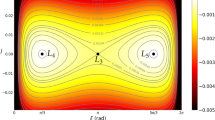Abstract
The aim of this paper is to study the dynamical problem of tidal friction in a binary system consisting of deformable components, with the restriction that the angle of lag or advance of the tidal distortion with respect to the direction of the disturbing companion is small. The fractional distortion of the bodies due to rotation and tidal interaction is also treated as a first-order small quantity, and terms up to the fourth harmonic in the tidal potential are retained. In this linear approximation, the time-dependent tidal potential can be Fourier decomposed into a spectrum of simple harmonic terms, each of which is responsible for raising a ‘partial wave’ in the body; each such partial wave can then be treated independently of the others. This is the method first employed by Darwin.
In Section 2, it is assumed that the phase lag in the response of the body (due to dissipation of kinetic energy of deformation) is proportional to the forcing frequency, which is justified for small amplitude oscillations of a viscous fluid or visco-elastic body. A simple expression is then obtained for the potential function for the distortion in terms of the disturbing potential and the structure of the body.
In Section 3, the distortion potential function is employed in deriving the componentsR, S andW of the disturbing force which are then substituted in the Gaussian form of the equations for variation of the elements. In Section 4, the Eulerian equations for motion of deformable bodies are derived, using the so-called ‘mean axes’ of the body as the rotating axes of reference. In Section 5, it is shown that the dynamical effects of rotational distortion occur on a much shorter time scale than those arising from tidal friction, which allows one to consider the two phenomena as acting independently of one another. The collected set of Gaussian (orbital) and Eulerian (body) equations is re-written in terms of dimensionless variables for the tidal friction case, and the stability of the system is examined on the basis of these equations.
In Section 6, the tidal friction equations are integrated numerically for the close binary system AG Persei and for the Earth-Moon system. In the former, the integrations were started from a highly elliptical orbit and the system was found to relax into a circular orbit, with synchronous rotation perpendicular to the orbit. In the latter, the integrations were performed backwards in time from the present day, and it was found that the lunar orbit rapidly becomes highly elliptical at the time of closest approach, thus indicating a probable capture of the Moon by the Earth. This result is in agreement with that obtained by other investigators; however, it is shown that the detailed behaviour of the system at the time of capture, in particular the inclination of the lunar orbit to the ecliptic, depends critically on the chosen rate of dissipation in the Moon's interior. A simple argument is presented which allows an estimation for the mean viscosity of a fluid body from the known age of the system: for the components of AG per, the result is 2×1011 g cm−1 s−1, indicating that the stars must have possessed turbulent convective outer regions during some part of their tidal evolution, while for the Earth, the result, is 1.4×1012 g cm−1 s−1. It is shown that the angle of tidal lag in nonsynchronous close binary systems in general is expected to be extremely small, and not observationally detectable.
Similar content being viewed by others
References
Blaauw, A.: 1952,B.A.N. 11, 405.
Brooker, R. A. and Olle, T. W.: 1955,Monthly Notices Roy. Astron. Soc. 115, 101.
Brouwer, D. and Clemence, G.: 1961,Methods of Celestial Mechanics, Academic Press, New York.
Colombo, G. and Shapiro, I. I.: 1966,Astrophys. J. 145, 296.
Darwin, G. H.: 1879a,Phil. Trans. Roy. Soc. 170, 1–35 (Paper 1).
Darwin, G. H.: 1879b,Phil. Trans. Roy. Soc. 170, 447–530 (Paper 3).
Darwin, G. H.: 1879c,Proc. Roy. Soc. 29, 168–181 (Paper 5).
Darwin, G. H.: 1880,Phil. Trans. Roy. Soc. 171, 713–891 (Paper 6).
Gerstenkorn, H.: 1955,Z. Astrophys. 36, 245–274.
Gerstenkorn, H.: 1967,Icarus 6, 92–109.
Goldreich, P.: 1967, in S. Runcorn (ed.),Mantles of the Earth and Terrestrial Planets, Ch. V, Section 6.
Goldreich, P. and Peale, S. J.: 1968,Ann. Rev. Astron. Astrophys. 6, 287–320.
Hadjidemetriou, J.: 1967,Adv. Astron. Astrophys. 5, 131–188, Academic Press, New York.
Jeffreys, H.: 1930,Monthly Notices Roy. Astron. Soc. 91, 169–173.
Jeffreys, H.: 1959,The Earth, Cambridge Univ. Press, New York, 4th Ed.
Kopal, Z.: 1959,Close Binary Systems, Chapter II, Chapman-Hall and John Wiley, London and New York.
Kopal, Z.: 1960,Figures of Equilibrium of Celestial Bodies, Univ. Wisconsin Press, Madison, Wis.
Kopal, Z.: 1965,Adv. Astron. Astrophys. 3, 89–118, Academic Press, New York.
Kopal, Z.: 1968a,Astrophys. Space Sci. 1, 411–423.
Kopal, Z.: 1968b,Astrophys. Space Sci. 2, 48–60.
Kopal, Z.: 1969a,Astrophys. Space Sci. 4, 330–364.
Kopal, Z.: 1969b,Astrophys. Space Sci. 4, 427–458.
Kopal, Z.: 1972a,Astrophys. Space Sci. 17, 161–185.
Kopal, Z.: 1972b,Astrophys. Space Sci. 18, 287–305.
Kopal, Z. and Shapley, M. B.: 1956,Jodrell Bank Ann. 1, 139–221.
Lamb, H.: 1932,Hydrodynamics 6th ed., Cambridge Univ. Press, Sect. 329.
MacDonald, G. J. F.: 1964,Rev. Geophys. 2, 467–540.
Morse, P. M. and Feshbach, H.: 1953,Methods of Theoretical Physics I, McGraw-Hill, New York.
Munk, W. H. and MacDonald, G. J. F.: 1960,The Rotation of the Earth, Cambridge Univ. Press.
Urey, H., Elsasser, W. M., and Rochester, M. G.: 1959,Astrophys. J. 129, 842–848.
Author information
Authors and Affiliations
Rights and permissions
About this article
Cite this article
Alexander, M.E. The weak friction approximation and tidal evolution in close binary systems. Astrophys Space Sci 23, 459–510 (1973). https://doi.org/10.1007/BF00645172
Received:
Issue Date:
DOI: https://doi.org/10.1007/BF00645172




